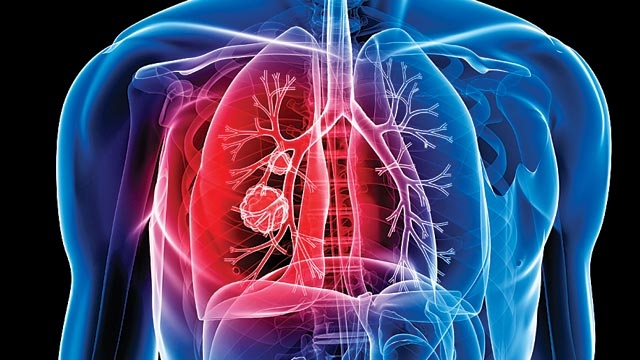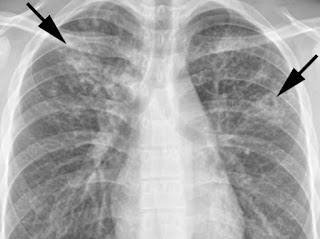
It is transmitted by respiratory route. The person with tuberculosis, transmits the microbe in saliva droplets by coughing or sneezing. This microbe can be inhaled by a healthy person who is in frequent contact with patients infected with tuberculosis. To develop TB usually you need to have daily close contact with someone who has this disease. For this reason, most people contract the disease from people with who share a long time, such as family members, friends or colleagues.
Tuberculosis symptoms
- People can present the following tuberculosis symptoms:
- Cough and expectoration for more than 15 days
- Weakness and constant fatigue
- Weight Loss
- Fever
- Night sweats
- Chest pain
- Coughing up blood
- Loss of appetite
If in the body is present latent TB there are no symptoms and can not be spread to others. If no active form of tuberculosis, no symptoms and the infection can be spread. Also there may be other diseases with symptoms similar to those of tuberculosis such as pneumonia and lung cancer. Active tuberculosis symptoms appear gradually and cover a period of several weeks or months. There may be some mild symptoms without the patient to suspect this infection.
Common Tuberculosis Symptoms:
- Cough accompanied by thick mucus, sometimes with blood (sputum) for a period of approximately two weeks
- Rapid heartbeat (tachycardia)
- Increased neck volume (affecting lymph nodes in the region)
Tuberculosis is a serious disease caused by an "active" bacteria. If the body's defenses are weak, it is possible to develop tuberculosis immediately after the bacteria enters the body. It is also possible that if the body's immune system, is weak dormant bacteria are reactivated, even after many years and they are causing disease. This can occur due to age, serious illness, abuse of drugs or alcohol, or infection of HIV (AIDS).
When the body's defenses are weakened and inactive tuberculosis bacteria become active it can get out of the walls, begin multiplying and damaging the lungs or other organs. If people with tuberculosis symptoms do not take drugs they can become seriously ill. But TB can be cured if these people have a proper medical treatment and take their medications as prescribed.
Mycobacterium tuberculosis
Tuberculosis is caused by Mycobacterium tuberculosis and can be relatively easily killed by exposure to sunlight (UV), disinfection and special chemicals (the simplest are the chlorinated). Koch bacillus has a special property of being able to inhibit the metabolism on long-term (10, 15, 20 years), in conditions unfavorable for its metabolism.
The existence of this "sleeping bacillus" in the body is the starting point of secondary tuberculosis, which occur at distance from the initial treatment. Another feature of this microbe is that is able to develop resistance to the action of specific antibiotics. Tuberculosis infection (penetration of Koch bacillus in the body) does not necessarily continue with illness of tuberculosis. First tuberculosis infection (natural or vaccine) has a positive effect on boosting immunity against a new tuberculosis infection. This happens but in terms of a healthy body.
Pulmonary Tuberculosis
Tuberculosis is a contagious infectious disease with chronic evolution, caused by Koch bacillus (bacillus tuberculosis) and which may affect all body organs, especially lungs. Any person can be infected with tuberculosis, regardless of social status and financial situation. There are exposed : people who are in constant contact with people with contagious pulmonary tuberculosis, people with low immunity caused by malnutrition and bad living conditions, HIV infected people, active smokers, people who drink alcohol and / or drugs, children who are not vaccinated against tuberculosis.
The main symptoms of pulmonary tuberculosis are cough with sputum for more than three weeks, fever for a week without an obvious cause, chills, pain in the chest, haemoptysis (sputum with blood removed by coughing), sudden drop in weight, loss of appetite, constant fatigue, excessive sweating, especially at night.
Tuberculosis Treatment
Current treatment of tuberculosis no longer takes a few years, as in the past. Currently, excellent results are obtained with treatments between 6 and 9 months, and only exceptionally in some serious forms or in some locations treatment lasts 12 months. But this treatment, relatively short compared to past, proved its effectiveness only if it is strictly observed. There are cases when tuberculosis treatment doesn't work but this happens because people don't cooperate. Among them are alcoholics.
Family plays an important role in tuberculosis treatment by creating an atmosphere conducive to healing the patient. In the struggle to achieve substantial improvement of the patient is given a state aid. Medicines are contain isoniazid, ethambutol, pyrazinamide, rifampicin. Besides allopathic treatment (tuberculostatics indicated by your doctor)patient should have a tuberculosis diet.
That means thet he has to avoid fatty foods that bother overnutrition and liver and cause digestive problems. It is preferably a mixed and varied diet that contains sufficient protein and raw vegetables rich in vitamins: dates, raisins, lemons, grapes, quinces (in haemoptysis), celery, beetroot, carrots, garlic, soy, honey, royal jelly, pollen. Rest after lunch at least 1-2 hours is needed for patients under intensive care.
How Do You Prevent Tuberculosis?
Early diagnosis and treatment of Tuberculosis : The most effective preventive measure is to prevent contagion. This is accomplished by removing the sources of infection in the community through the detection, early diagnosis and complete treatment of cases of smear-positive pulmonary tuberculosis (BK +).
BCG vaccination : The BCG vaccine is applied to six years old infants. This vaccine protects children against serious tuberculous meningitis and miliary tuberculosis.
Chemoprophylaxis : It consists of daily administration of Isoniaciada (H) 5 mg / kg / day for six months. Chemoprophylaxis reduces the risk of developing the disease in infected children.
Health education : It is addressed to the patient, his family and the general population. The aim is to reduce disease transmission in the community.
Is there any difference between tuberculosis disease and latent TB?
Latent TB infection is the presence of the germ in the body wich causes symptoms. The pacient has reaction to the Mantoux test. If you have latent TB you can not spread the germ. You can spread it only if you habe TB disease. The infection may persist for the entire life and never turn into disease. Tuberculosis symptoms may include a slight fever, persistent cough and fatigue. Some people may not have obvious tuberculosis symptoms. The majority of the people who are infected by the germ do not develop active tuberculosis. The risk of active TB declines over time.Extrapulmonary Tuberculosis
Extrapulmonary tuberculosis is a form of tuberculosis that affects other organs than lungs like liver, kidney, lymph node.There also can be peritonitis, pericarditis and spinal tuberculosis.




No comments:
Post a Comment